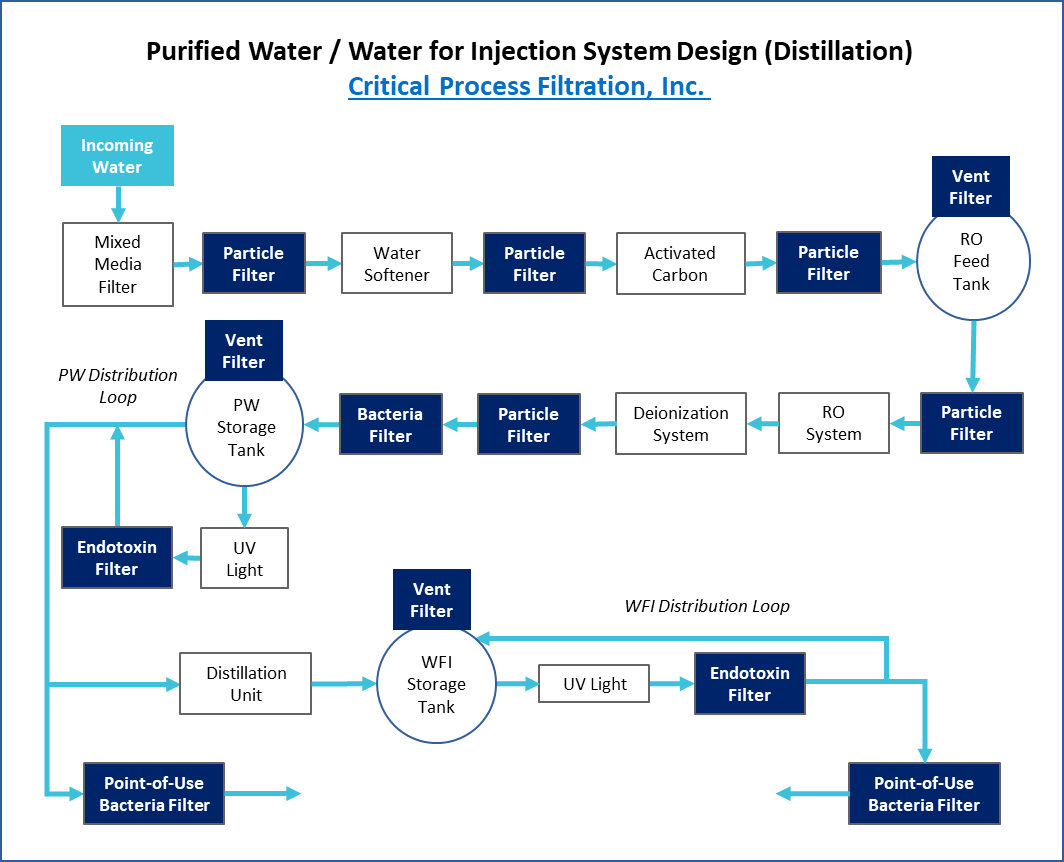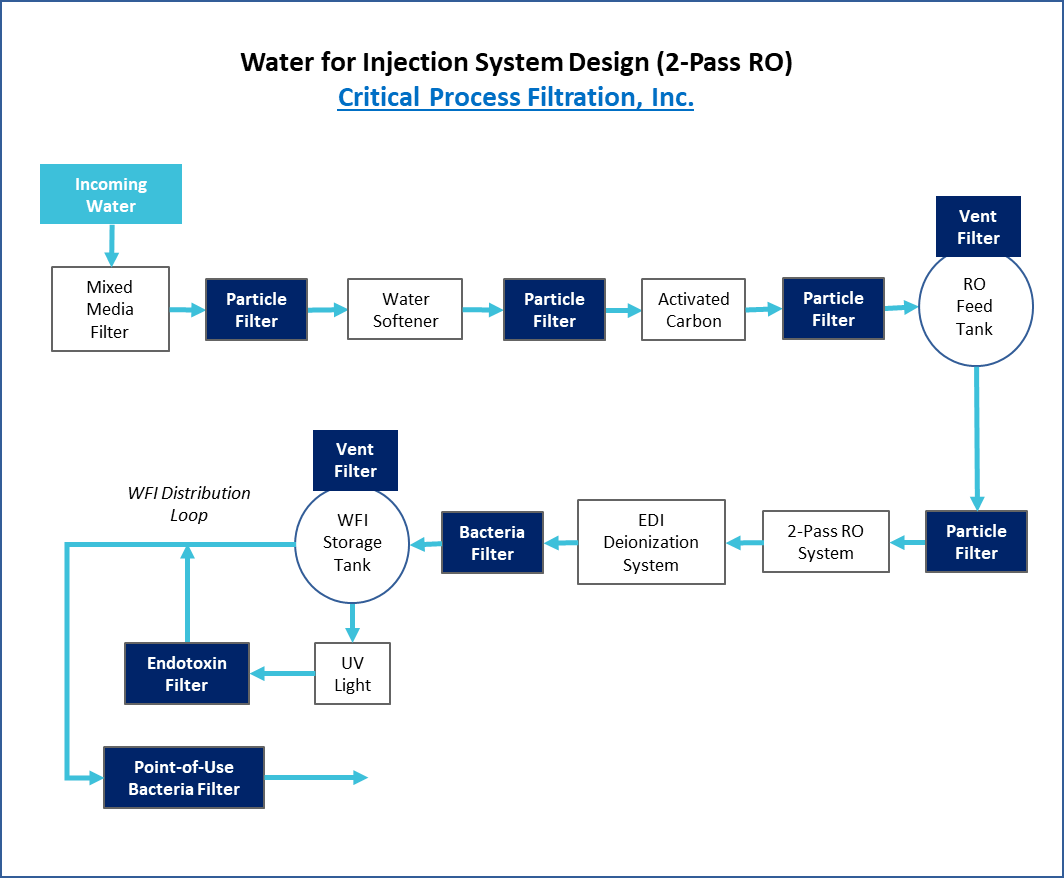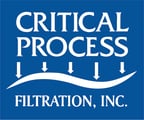As water is a key ingredient in pharmaceutical and biopharmaceutical processes, the approach to purifying water for its intended use is critical to achieving the necessary result.
Whether used for washing equipment and containers, as a solvent, or as an ingredient in the final product, the water must meet stringent quality requirements as directed in applicable standards - United States Pharmacopeia (USP), Pharmacopeia Europa (EP), Japanese Pharmacopeia, etc.
These regulatory agencies describe the criteria (monographs) for treated water depending on the intended use. The two main classifications for bulk treatment in pharmaceutical water systems are Purified Water (PW) and Water for Injection (WFI). The regulatory agencies make recommendations on how water should be processed - generally Reverse Osmosis / Deionization (RO/DI) for Purified Water followed by distillation for Water for Injection, but they do allow for some flexibility as long as the water meets or exceeds the requirements.
Pharmaceutical Water Requirements
The specifications for purified water are very similar across the different regulatory agencies. In addition to requiring very low levels of soluble impurities (heavy metals, chlorides, nitrates, etc.), the following are specified:
- TOC: < 500 ppb C
- Aerobic Bacteria: < 100 CFU/ml
- Conductivity: < 1.3 S/cm @ 25oC (EP limit slightly higher)
The specifications for WFI are similar, with the following exceptions:
- Aerobic Bacteria: < 10 CFU/ml
- Bacterial Endotoxins: < 0.25 EU/ml (there is no endotoxin specification for PW)
Producing Bulk Pharmaceutical Water
The exact methods for treating water to meet the established specifications are left intentionally flexible in the USP, EP, and JP standards. The basic assumption is that the water system will start with potable water, and employ a suitable process for purification. To produce Purified Water, most systems use reverse osmosis followed by deionization, along with required pre- and post-filtration depending on the initial water quality. Many existing systems for WFI use distillation to further process PW, as this has been widely accepted throughout the world. Newer systems may employ alternate methods, such as double-pass reverse osmosis, as the majority of Pharmacopoeias now recognize these alternatives as acceptable.
While RO/DI and Distillation are the main technologies used to produce pharmaceutical water, there are many points in the water system where cartridge filters are employed to optimize system performance, prevent unwanted contamination and extend the life of the major components. The cartridge filters that may be used fall into four categories.
- Particle Removal filters. These could be used to remove particle shedding from various treatment steps, such as softeners, mixed media beds, or carbon filters. They could also be used to remove particles that may prematurely foul the RO system.
- Bioburden Reduction and/or Sterilizing filters. These can be installed anywhere there is a risk of bacterial contamination. The exact type and placement would be determined by conducting a process risk assessment. A sterilizing filter is often installed at point-of-use outlets as a final level of assurance.
- Tank Vent and Process Gas Filters. All tanks must be isolated from the environment as they fill and drain. A hydrophobic Bioburden Reduction or Sterilizing filter should be installed for each tank in the process. If any process gasses (compressed air, etc.) are used that may contact the water, proper filtration is essential. Here again, the choice of filter would depend on the identified risk of contamination.
- To protect the storage of PW and to produce WFI, an endotoxin removal filter is employed to make sure the water meets the specified limits.
Figure 1 below shows a possible PW/WFI water system using RO/DI followed by Distillation. This schematic shows separate distribution systems for PW (washing, steam generation, etc.) and WFI (pharmaceutical manufacturing process).

Figure 1: Purified Water / Water for Injection System Design (Distillation). Dark blue boxes represent filters by Critical Process Filtration.
Figure 2 shows a similar system using RO/EDI to produce WFI. Only one distribution loop is shown as the WFI can be used for PW applications as well.

Figure 2: Water for Injection System Design (2-Pass RO). Dark blue boxes represent filters by Critical Process Filtration.
These schematics probably do not match your process exactly, as every water process is different. Depending on the quality and source (municipal versus well) of incoming water your system may require fewer steps before the RO system. The presence of an unusual substance to be removed may require a filtration step unique to that substance. These schematics are presented to illustrate where and what types of cartridge filters may be used in a pharmaceutical water system.
Cartridge Filter Applications in Pharmaceutical Water Systems
As mentioned above, cartridge filters commonly used in pharmaceutical water systems fall into four categories.
Particle Filters
As shown in the schematics, there are many places in a water system where particle filters might be installed. Many of the initial water conditioning steps - mixed-media bed, water softener, activated carbon, RO prefiltration, and mixed-bed deionization - are prone to shedding particles, especially as the media breaks down over time.
Some of the filters shown may have more specific designations for your system. For example, the filter after the activated carbon system might be called a carbon fines trap. The filter after a mixed-bed deionization system might be known as a resin trap. They all serve the same purpose: preventing these particles from affecting downstream operations.
Selecting the proper filter requires consideration of several factors: • Expected particle size • Expected particle load
- Flow rate
- Life expectancy requirements
- System cleaning procedures (hot water, chemical, etc.)
These factors will help determine the type of filter, pore size, and number of filters required. Testing may be required to confirm.
For lower particle loading, Critical Process Filtration offers polypropylene melt-blown or polypropylene nano-spun depth filters. For higher particle loading and long life requirements, CPF pleated depth filters may be a better option. Although they cost a little more, the improved retention efficiency and dirt-holding capacity can extend the processing time between replacements, making them the more cost-efficient option.
Bacteria Filters
Although an appropriately operated RO system should be capable of producing bacteria-free water, it is generally recognized that there may be a potential for low-level bacterial contamination downstream of the system. For this reason, many water system operators will install a bacteria removal filter after the RO step. This will usually be a validated sterilizing filter to provide maximum protection of water quality. Critical Process Filtration offers 0.22- and 0.1-micron sterilizing grade filters in both Polyethersulfone and Nylon 6,6.
Bacteria removal filters are also installed at point-of-use outlets off the water distribution system. On a system with a Purified Water distribution loop, this may be either a sterilizing or a bioburden reduction filter. The choice should be based on a risk assessment of the likelihood and subsequent consequences of contamination. Bacteria removal filters installed in a Water for Injection loop should always be sterilizing grade. In addition to the sterilizing filters listed above, Critical Process Filtration offers bioburden reduction filters with Polyethersulfone, Nylon 6,6, and PVDF membrane options.
Tank Vent and Process Gas Filters
All tanks must be properly vented to ensure structural integrity. Venting allows air to leave the tank as it is filled and enter the tank as it is emptied. Installing the appropriate vent filter will prevent particles and bacteria in the surrounding environment from entering and possibly contaminating the tank. These filters must be hydrophobic to prevent the membrane from becoming wet with water, which would block the airflow. Any process gas that will contact the process water must also be filtered to prevent contamination.
In a pharmaceutical water system, these vent and process gas filters should be either bioburden reduction or sterilized. As indicated above, the choice should be made based on a proper risk assessment.
Critical Process Filtration offers bioburden reduction gas filters with either PTFE or PVDF membrane. Sterilizing vents and gas filters are offered with PTFE membrane. Sizing these filters will depend on expected flow rates when filling and emptying tanks to ensure adequate airflow rates.
Endotoxin Removal Filters
Although great care has been taken to remove bacteria from the water before it enters the storage tanks, many systems will employ additional disinfection measures as additional assurance. Some loops are kept at elevated temperatures to prevent bacteria from growing. Other systems employ a recirculation loop utilizing a UV system to kill any bacteria that may have gotten into the water. As shown in the schematic, the UV is often followed by an endotoxin removal filter which will remove any bacteria debris generated in the UV chamber. These filters are sterilizing-grade membrane filters with a positive charge to ensure endotoxin removal. Critical Process Filtration offers positively charged Nylon 6,6 or PES membrane filters.
Conclusion and Summary
Pharmaceutical water systems require many steps to produce water that meets applicable standards. Installation of the appropriate particulate, bacteria removal, and vent filters will help ensure water quality, thus ensuring product sterility and patient safety. Critical Process Filtration supplies a wide range of filter materials and configurations allowing optimization of your filtration process while minimizing filtration costs.
Filter Options for Particle Removal, Bacteria Removal, Vent & Gas Filtration, and Endotoxin Removal
Particle Removal
- GDMB (melt-blown polypropylene)
- NSPD (nano-spun polypropylene)
- PPD (polypropylene depth filter)
- PGD (fiberglass depth filter)
- BCWPS (high capacity PES)
Bioburden Reduction for Liquids
- BPS (PES membrane; High capacity PES prefilter layer optional)
- BNM (Nylon 6,6 membrane)
- BPVWL (PVDF membrane)
Bioburden Reduction for Gas
- BTM (PTFE membrane)
- BPVWB (Hydrophobic PVDF membrane)
Sterilizing Liquids
- PPS (Dual layer PES membrane)
- SPS (Single layer PES membrane)
- PNM (Nylon 6,6 membrane)
Sterilizing Gas
- PTM / PTR (PTFE membrane)
Endotoxin Removal
- PNC (charged nylon 6,6)
- PPC (charged PES)
